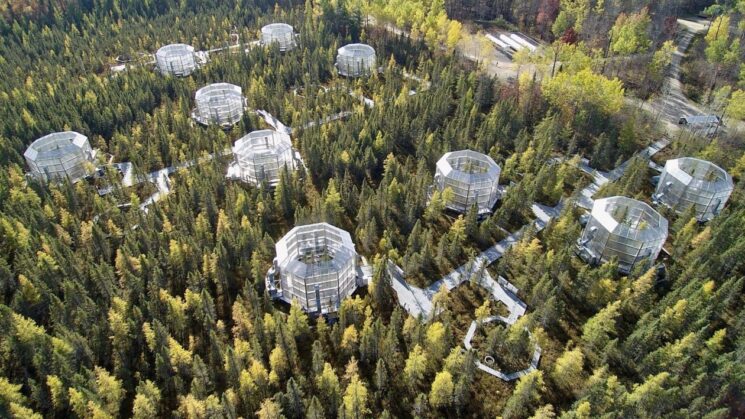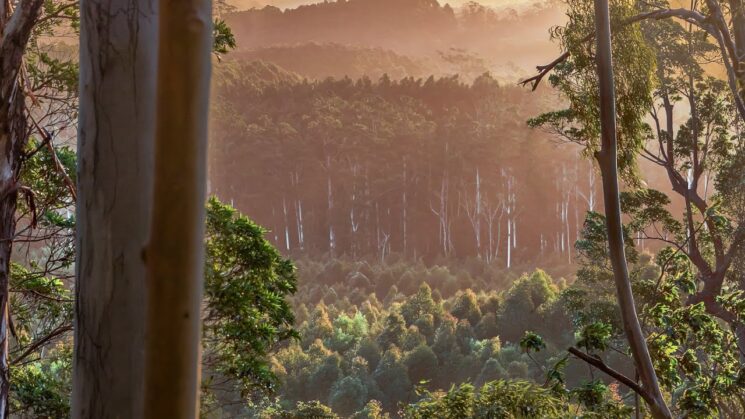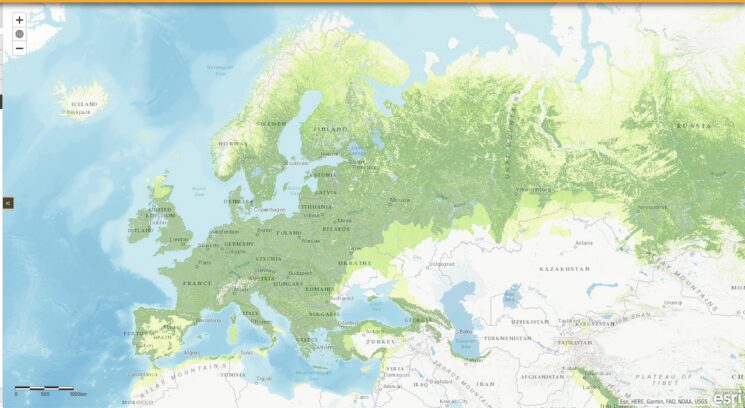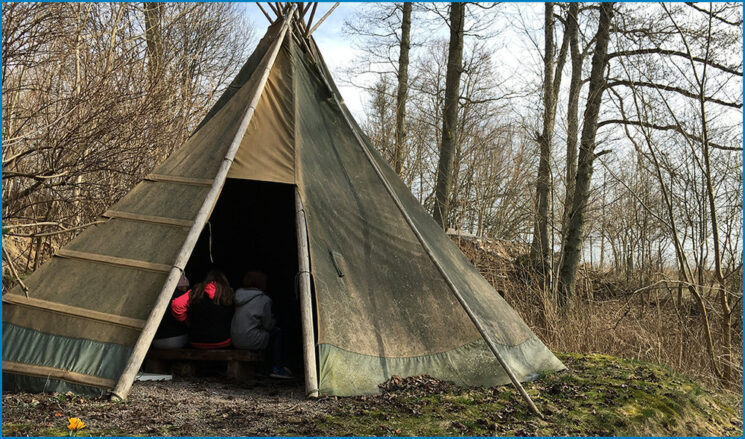Sweden extends from the southern Baltic Sea to north of the Arctic Circle. The country has an area of 450,000 km (174,000 sq. mi.) and is 1,600 km long, equal to the distance from the southern tip of Sweden to southern Italy. 
Despite its northerly location, the climate is fairly mild and temperate, due to the warm Atlantic Gulf Stream. Annual precipitation varies from 1,500 mm in the country’s western portions to 300 mm in the eastern portions. The growing season lasts 240 days in the south and 100 days in the north. Mean temperatures range from 14-17°C (58-62°F) in July to between +1 and -14°C (32- 7°F) in January-February.
Most of Sweden has a relatively even topography and is less than 300 m above sea level. In the northwest, the Scandinavian mountain range reaches heights of 1,000-2,000 m above sea level. These mountain peaks are not forest-covered. The timberline varies from 700 m above sea level in the southern portion of the chain to 400 m in its northerly portion.
The country’s forest soils chiefly consist of moraines which were deposited when the inland ice cap melted 10,000 years ago. Most Swedish forests are part of the Boreal coniferous belt.
Due to the low buffering capacity of Swedish forest soils, a high level of air pollution-mainly originating abroad-has resulted in widespread soil acidification. Leaching of mineral nutrients has thus reduced their level by half in recent decades. Critical loads are being exceeded, both in terms of sulfur dioxide and nitrogen dioxide deposits. Air pollution poses a serious threat to the forest eco system and to the growth of forests.
Forest history
Although Sweden is a sparsely populated country-with 8.8 million inhabitants in an area slightly larger than California but somewhat smaller than Spain-its forests show the impact of many centuries of human use. Only in the northern interior are the forests less affected by humans. Today these virgin-like forests are largely protected, either as nature reserves or by other means.
In southern Sweden and other regions of the country with a long agricultural tradition, forests served as a source of wood for construction, fuel and the production of numerous useful objects and tools in an overwhelmingly agrarian society.
For a long time, especially in southern and southwestern Sweden, farmers cut and burned forests to create fields for short-term cultivation, thereby depleting nutrients from the soil.
As early as the Middle Ages, the forests supplied raw materials used in important Swedish export products. For several centuries, wood tar, pitch and potash were major sources of income. By supplying charcoal, the forests were also a prerequisite for perhaps the most important single industrial sector: mining and metals. This was especially true in central Sweden. Due to rapid population growth in the 19th century (which triggered large-scale emigration to the United States), Swedish forests came under increasing pressure. Wooded areas were cleared to accommodate the proliferation of smallhold leases. Forests were thinned so that grass could be cultivated to sustain bigger herds of livestock.
Early in the 19th century, Sweden began the process of industrialization by rapidly expanding its sawmill industry. The vast untouched forest resources of Norrland (the northern 3/5 of Sweden) thus began to be tapped. The major Norrland rivers were suitable for floating timber to the Baltic Sea, thereby opening up hitherto untouched inland forests to massive logging. The sawmill companies, which purchased very large tracts of land from farmers until 1905, soon gained a strong position on European timber export markets.
Changes to boreal forest ecology

The boreal forest landscape in Sweden has changed dramatically during the last 150 years. The standing volume of trees decreased up until the 1950’s due to more and more intensive logging. Despite the intensive forest management after that time it has not yet reached the level of the late 19th century. Even more striking is the change in forest stand structure. The areal extent of forests older than 150 years has decreased dramatically. Figures from different regions of the boreal forest also indicate that the volume of dead standing trees has decreased by more than 90 % over the last 100 years. Large diameter specimens of Scots pine (Pinus sylvestris L.) and Norway spruce (Picea abies), which characterized the virgin boreal forest, have decreased by more than 80 % during the same period.
Northern Sweden was very sparsely populated until the beginning of the 19th century. At that time an accelerating agrarian colonization took place, and later during that century a large-scale exploitation of the virgin forest began. The first forest resources to be exploited were those close to the Bothnian coast, and subsequently exploitation moved further inland. This exploitation affected almost all forest land in northern Sweden during the period 1850-1950.
In many areas of northern Sweden forest inventories preceded exploitation. They were often carried out as tree counts, i.e. measurements of large diameters trees as well as an estimation of their saw-timber quality. This inventories can, together with more accurate inventories carried out at a later time, be used to estimate the standing volume as well as tree diameter distribution in the unexploited forest. In some cases the number of dead standing trees was also recorded.
The exploitation of the forest meant that in most areas the average standing volume of trees was drastically lowered before any forest cultivation and stand treatment began. In two areas in the southern part of the boreal forest the standing volume of today is 25% to 40 % lower than it was before any exploitation had taken place. Forest surveys, from 1870, of northern Sweden show a similar pattern, although this material also includes forests that had already been exploited to some extent when the first inventories were made. The standing volume of today is less than it was 120 years ago despite the more intensive forest cultivation and management practices of the latest decades.
The conversion of virgin forest to managed forest did not just affect the standing volume. Changes were even greater when one considers the structure of the forest. The virgin forest was characterized by a multiple age and size structure. This multi-layered structure has to a large extent been replaced by a uniform structure and relatively even-aged, young forest stands. The areal extent of older forest has decreased dramatically.
The proportion of forest older than 150 years has decreased from 43.5 % to 7 % during the last 80 years on state forests land. Today the trees are seldom allowed to reach maturity. The forest stands are normally clear-cut at the age of 100-150 years, which is also recommended by the Swedish silvicultural law. However, the natural life span for Norway spruce is around 250-500 years, and for Scots pine 300-600 years. Old, large diameter pine and spruce were abundant in the virgin forest. These trees have been successively cut during the last 150 years, and as trees today never reach such old ages and large diameters, the number of such trees has decreased substantially.
Wild fires and the natural dynamics prior to exploitation created large amounts of dead wood in the forests. Standing dead trees and snags and logs on the ground were very abundant. This coarse woody debris has to a large extent been removed during the 20th century through forest management. It is not created any longer because dead or dying trees are consistently removed from the forest, and the most important disturbance factor, fire, has disappeared from the forest due to active fire protection.
Figures from two areas shows that the amount of dead standing trees has decreased more than 90 % during this period (Fig. 11). This development has created a serious problem since the survival of many organisms, including rare species of birds, insects, lichens and fungi depends on the availability of these types of habitats.
In the Norrland interior-the most sparsely populated area of Sweden, with low timber yields and a severe climate-the State has always been the dominant forest owner. In this part of the country, a dearth of alternative sources of livelihood has made the forest crucially important to employment and human settlement.
History and forest management legislation

Nordic forests have a centuries-old history of silvicultural activity. For many centuries, slash-and-burn-farming practices were widespread in large parts of Sweden. Cutting down and burning vegetation within a forest site created good conditions for the cultivation of various crops in the resultant layer of ash for two to three years. No fertilizer was provided for the soil, so it quickly became impoverished. The population then moved on to a new location where they again burned the vegetation for a few years cultivation. In parts of the Nordic region people repeated this sequence in about 40-year intervals. Slash-and-burn practices mainly ceased in the middle of the 1800s.
Since the seventeenth century, in central Sweden enormous amounts of wood were needed in the different mines and for melting metal ore. At this time, timber from the forests was also used extensively in Sweden for the production of prime quality tar.
Sweden and Finland were the first countries where forest conservation laws came into effect, in 1886 and 1903 respectively. These laws stipulated that felled areas were to be reforested. But planning and growing large areas of forest was not sufficient. In the wake of rationally managed forests, criticism of monoculture and, after the Second World War, the adverse effects of large-scale operations grew. In time, self-criticism also increased and research was able to show other adverse trends with regard to certain flora and fauna. This was a result of highly production-oriented forestry and forestry policies.
Even a long time after the war forests were at times exploited in ways that today, with increased knowledge and insights, were detrimental to the environment. In the 1960s and 1970s, extensive clear cutting was carried out in the name of rationalisation. Little effort was made to protect biodiversity.
However, nearly a hundred years ago, a special Forestry Act stipulated that Swedish timberlands could no longer be freely exploited. Instead, sustainable forestry would provide the basis for future operations. Replanting, good forest management and long-term planning have subsequently led to a very large increase in timber supplies. This made possible a steady expansion of logging operations. Today’s timber stock is 50% larger than it was when detailed measurements began in the 1920s. Since the 1992 UNCED meeting in Rio, the concept of sustainability has broadened. This is reflected in the revised Swedish forestry policy that went into effect in 1994.
Both Sweden has subsequently supplemented and renewed their respective forestry legislation. This has occurred in tandem with new research findings and by consistently setting new objectives for forestry.
In Sweden, an updated Forestry Law came into effect in 1994. It states the following:
“The forest is a national resource which should be managed so that it provides a good return on a sustainable basis and ensures the preservation of biodiversity.”
National parks and nature reserves
The national parks are the most well protected nature areas. These selected areas of the landscape, together with their animals and plants, are totally protected against all forms of exploitation, to the benefit of the environment and humans. National parks are intended to guarantee that future generations will be able to experience unspoiled natural settings, and it is also an important place for conducting studies and research. Parks and reserves are one of several ways of achieving the long-term environmental goals and the preservation of biodiversity.
Sweden has 25 national parks that together cover a total of more than 6,000 km 2, or 1.5% of the country’s area. Sweden also has 1,563 nature reserves covering 25,617 km 2, or around 5.5% of Sweden’s total area.
To this is added the nature reserves and other areas which are increasingly being provided by private forest owners, from individual forest owners to large forest industry companies.
Forest resources in Europe are growing larger

In Europe the forest area and the growing stock are increasing year by year. This depends to a great extent on the decreased demand for wood as a domestic fuel and on the replanting of forests. The forest area is increasing by about 4,000 km 2 each year. In nine years, this area will equal the total area of the Netherlands.
In the Nordic region, there is now more wood in the forests than at any time in the last hundred years. In the region, forest assets have increased and almost doubled over the past one hundred years. Sweden harvests approximately 70% of total growth. Analyses of future developments show that wood stocks in the Nordic countries will continue to grow. Forest capital therefore increases annually.
SWEDEN – GROSS WOOD HARVESTS (CUTTING)
millions of cubic metres
Swedish Forest Industry and Ownership StructureWhat is especially apparent when comparing Sweden to other timber-producing countries around the world is that the State owns only 5% of the productive forest lands. During 1993 most government-owned timberland was transferred to a forest product corporation – AssiDomän – in which the State owns 51% of the shares, and the remaining 49% are quoted on the stock exchange.
Private individuals (families) are the largest single category of forest owners in Sweden. In Sweden, approximately half of the country’s forests are family owned. Forest companies own approximately 3 % and other owners account for 12%. The average size of a private forest is about 50 hectares in Sweden. In the southern part of the country, they are the dominant category, accounting for 80% of forest land. Until World War II, most private forest owners were farmers who lived on their property and were engaged in crop cultivation as well as forestry. Since then the area of forest land employed by this type of combined agriculture and forestry enterprise has dropped from more than 9 million to less than 4 million hectares. Today many individual forest owners do not live on their forest land, but often in communities close to it or in more faraway cities and towns. The bulk of forestry work on their properties is now performed by employees of the forest owners’ associations or by other contractors.
Forest companies are the second-largest category of forest owners in Sweden. Their holdings are concentrated in central Sweden and some portions of Norrland, where they also operate many large, modern production facilities. Swedish forest companies, including such names as Svenska Cellulosa AB (SCA), Stora, Mo & Domsjs (MoDo), Korsnäs and Graningeverken, are among the global leaders in their fields. Over the past 20 years they have also globalized their operations and established themselves firmly in the European countries and also on other continents. Currently some 8 million ha of forest land have been certified in Sweden. Forest companies account for most of the certified forest land.

National forest policy

In Sweden, legislation on forest ownership and management dates back a long way. Because of their major economic role, forests have been a topic of regulations ever since the provincial laws of the 13th century.
The national forest policy currently in force was enacted by Parliament in 1993. It incorporates the commitments made by Sweden at the United Nations Conference on Environment and Development (UNCED) at Rio de Janeiro in 1992. Underlying this policy is the conviction that there will continue to be a demand for renewable products in the future and that Swedish forests can remain an important raw material base for processes that are based on principles of ecological cycles. Goals for both forest production and forest environment have been established. These two types of goals carry equal weight. The preservation of biological diversity is a key element of the new forest policy.
Sweden’s forest policy states that, as hitherto, forest management will be characterized by multiple uses. Forests should be able to sustain hunting and the gathering of wild mushrooms and berries as well as active silviculture. The traditional Swedish “right of common access” implies that regardless of who owns the land, everyone is entitled to hike through the natural landscape and to pick mushrooms and berries that grow there.
This is an important element of the multiple-use concept, but it also assumes that people behave in a respectful way. To the Swedes, common access is an important tradition and a privilege that is rarely abused. In northern portions of the country, the Sami (Lapp) minority pursue reindeer husbandry in forest lands on the basis of ancient rights. The Sami are legally entitled to use lands that belong to others in order to feed and protect their reindeer herds.
Swedish forest policy assigns “sectorial” responsibility for the environment. One consequence is that forest owners and forestry workers are responsible for obtaining the requisite knowledge to fulfill environmental measures. A few years ago, a major ecological and environmental training campaign was carried out. Known as Richer Forest (Rikare Skog), the campaign involved 100,000 participants and has already led to environmentally sounder forest management in Sweden. From 1999-2002 a Greener Forests (Grönare skog) campaign will be underway. The campaign is about how Forestry can effectively combine high economic production with advanced environmental benefit. The goal here is also to involve 100,000 participants.
Since 1903 there has been legislation which requires planting and cultivation of new forests after logging.
Today’s forest legislation contains provisions aimed at protecting key woodland habitats for flora and fauna, selected valuable broad-leaved deciduous trees (mainly oak and beech), forests located near high mountains and wetland forests. There are also special regulations governing some 4 million hectares of low-productive woodlands that are not included in the productive forest land. These regulations allow only careful low-intensity utilization, ensuring that the character of these woodlands will remain unchanged. Key woodland habitats function as the nodes of an ecological network, while forest wetlands and low-productive woodlands often comprise ecological corridors in the landscape.
Before new silvicultural methods or new forestry materials are put into use, a description of their environmental consequences must be presented to the Swedish forestry administration.
Sweden has a forest gene bank, which is responsible for preserving the original genetic material of the country’s tree species.
Organizations

Numerous government agencies, industry organizations and others are active within the forestry sector. Sweden’s ministries are small, but subsumed under them are many relatively autonomous civil service agencies.
The chief responsibility for forest policy is vested in the Ministry of Industry and Commerce, whereas the practical application of forest policy rests with the Swedish forestry administration. This consists of the National Board of Forestry (Skogsstyrelsen) located in Jönköping, and the 10 County Forestry Boards (Skogsvårdsstyrelser). Locally there are some 100 districts where forestry-trained personnel are in close touch with the forest owners. The forestry administration is called upon to promote forestry; its operations include implementation of the Forestry Act, advisory services, distribution of government grants to forest owners performing contractual services, forest inventories, information activity, certain ecological matters, timber scaling regulations, forestry statistics and forecasts of trends in the forestry sector.
Many of the family forest owners are organized into seven forest owners’ associations. The associations cooperate in the Swedish Federation of Forest Owners (Skogsägarnas Riksförbund). Their 89,000 members own 5.8 million ha of forest land (about 50% of all family held forest land). The associations were formed to improve the financial yield of forestry operations among their members. This is done by coordinating the timber trade and by helping the forest owners with logging and silvicultural practices. In order to ensure a steady market for timber and to control pricing, the associations have built up their own forest companies.
The Swedish Forest Industries Association (Skogsindustrierna) is the main organization of the forest industry, with 14 companies as members. The task of the association is to monitor and represent the interests of its members, while creating broader public understanding of the need for a competitive forest industry in Sweden. Among its other tasks are to promote and monitor the interests of its member companies abroad.
Sweden’s forest companies are manufacturers of a wide spectrum of pulp, paper and sawn goods. The Swedish Forestry Association (Sveriges Skogsvårdsförbund) is an independent, non-profit organization which promotes forestry and related nature conservation. It organizes forestry conferences and excursions, and provides information about the forestry sector.
Education, training and research

Programs of forestry education are offered by upper secondary schools and by the Swedish University of Agricultural Sciences (Sveriges Lantbruksuniversitet, SLU).
Various upper secondary schools give a basic three-year course as well as special courses for machine operators, forest farmers and foremen. From the autumn of 1996 a three-year program for 65 Forest Engineers per year will start at the National School for Forest Engineers. As a consequence of this, the previous two-year training for Forest Technicians will cease.
Up to the year 2000 SLU will produce 65 “jägmästare” (MSc degree in Forestry) per year after a training period of five years. In the autumn of 1996 a new four-year master’s program in Forestry (Skogsvetare) started with 140 students per year. This program will gradually replace the five-year program. All the above schools provide not only basic courses but also in- service training. Moreover, the County Forestry Boards and the Forest Owners’ Associations provide family forest owners with large-scale advisory services and extension courses.
Most forestry research in Sweden is carried out by the SLU’s Faculty of Forestry. Its 22 research departments deal with all the biological, technical and economic disciplines of forestry.
The Forestry Research Institute SkogForsk works with applied research for a sustainable, profitable and ecologically sound forestry. The Institute has four fields of research – Raw materials and the wood market, Silviculture and conservation, Breeding and propagation, and Operations systems. Its research program is financed jointly by the forestry sector and the government. A large amount of the research is carried out in the forests in close cooperation with various forest enterprises.
Culture and recreation

For several years Swedish industry has worked to make forestry environmentally adapted. But it is not only the forest environment with its flora and fauna which is taken into consideration. Of equal significance is consideration of cultural remnants and other activities in the forests.
Sweden became inhabited as the last ice age came to an end. To varying degrees, cultural remains from post ice-age periods can be found, such as runic stones or burial sites from the Viking era. Preserving archaeological finds from our earliest history is a given feature of Swedish forestry.
In purely practical terms, trees surrounding sites such as ditch traps or rune carvings on dead tree stems can be left undisturbed during felling operations. Such cultural considerations usually take the form of joint programs with various local authorities. More modern cultural remains, such as livestock huts, are of equal importance. No planting takes place on the cultivated land often included in the hut sites, and in connection with felling operations a strip of vegetation is left around the hut and its plot.
Hunting remains a widespread and significant activity of modern life in Sweden. Similarly, fishing is a major leisure activity for many. Both hunting and fishing need to be taken into consideration since they are naturally connected to forestry’s key environmental considerations.
Sports such as orienteering, cross-country skiing, as well as berry-and-mushroom picking are other popular activities which take place in the forests. It is therefore important that we protect our old roadways, paths and the like.
The Sami people, who inhabit the northern Nordic area, are dependent on the forest for grazing land for their reindeer. They earn their living from reindeer breeding, and reindeer wander through different areas throughout the year. The forest owners affected by this cooperate with Sami communities to ensure that reindeer herds can live according to their natural requirements.

